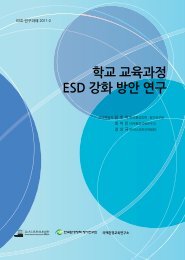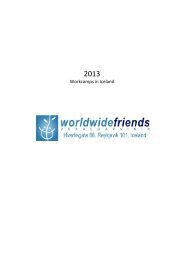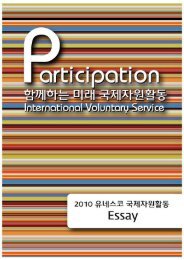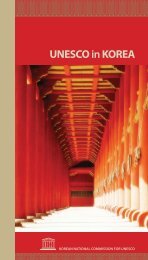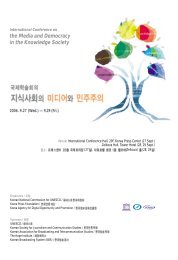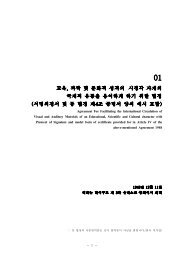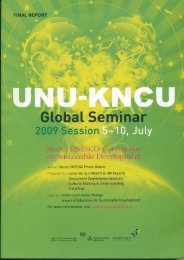DMZ ì¼ì ìí ííì ê´ë¦¬ë¥¼ ìí êµì 컨í¼ë°ì¤ - ì ë¤ì¤ì½íêµììí
DMZ ì¼ì ìí ííì ê´ë¦¬ë¥¼ ìí êµì 컨í¼ë°ì¤ - ì ë¤ì¤ì½íêµììí
DMZ ì¼ì ìí ííì ê´ë¦¬ë¥¼ ìí êµì 컨í¼ë°ì¤ - ì ë¤ì¤ì½íêµììí
Create successful ePaper yourself
Turn your PDF publications into a flip-book with our unique Google optimized e-Paper software.
International Conference on Conservation and Peaceful Use of the Korea <strong>DMZ</strong><br />
(South Africa). This Conference, organised jointly by IUCN and Peace Parks Foundation, was<br />
one of the founding grounds for IUCN’s development of a widely acclaimed guideline on<br />
transboundary protected areas, including the Draft Code for Transboundary Protected Areas in<br />
Times of Peace and Armed Conflict. The Guideline was developed by IUCN’s World<br />
Commission on Protected Areas - Transboundary Protected Areas Task Force (recently renamed<br />
to the Transboundary Conservation Specialist Group).<br />
IUCN defines Parks for Peace as "transboundary protected areas that are formally dedicated to the<br />
protection and maintenance of biological diversity, and of natural and associated cultural<br />
resources, and to the promotion of peace and cooperation." It therefore combines ecological and<br />
social elements and encompasses collaborative management of natural areas for improvement of<br />
the existent social and political systems. Establishment of Parks for Peace is gaining much<br />
support from countries, especially those that were involved in some form of conflict. Although<br />
environmental issues usually do not suffice for conflict resolution, Parks for Peace, as research<br />
and practice has shown in recent years, have significant role in peace building, by providing a<br />
constructive, optimistic and fruitful atmosphere of collaboration and mutual understanding. Parks<br />
for Peace open a path to dialogue, cooperation and confidence building between concerned<br />
parties. Socio-cultural dimension is reaching its full potential in this type of transboundary<br />
conservation practice with building of trust, understanding and reconciliation. Combined with<br />
cross-border cooperation for more successful management of natural values of a particular area,<br />
Parks for Peace provide a valuable mechanism for testing innovative management and<br />
governance models in protected areas while supporting maintenance and establishment of good<br />
relations between countries.<br />
Politically, transboundary conservation initiatives offer possibility for regional stability and<br />
environmental security. Often referred to example of successful transboundary conservation<br />
efforts in peace building is the case of Peru and Ecuador. The Peace Agreement of 1998<br />
included designation of areas on both sides of the border for conservation purposes, which<br />
helped resolve conflicts related to boundary demarcation. Subsequently the Cordillera del<br />
Condor Peace Transborder Reserve was established, as the first Park for Peace involving the<br />
countries in armed conflict, while celebrating cooperation between the two countries.<br />
Transboundary conservation initiatives are complex and often difficult to implement as they<br />
entail a range of issues, often conflicting, that need to be negotiated between two or more<br />
countries that usually have unequal human, financial and technical resources, different legal<br />
settings etc. However, they create an entry point for discussions between countries divided by<br />
economic, social, environmental interests, bringing families and other people together across an<br />
artificial border and addressing ecological issues.<br />
Nature, Peace and Local Development ❙ 15



